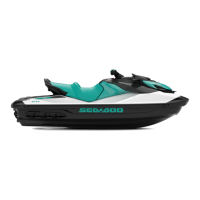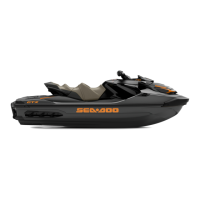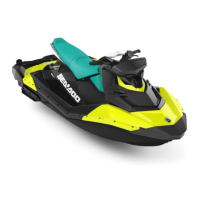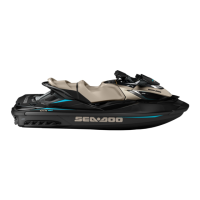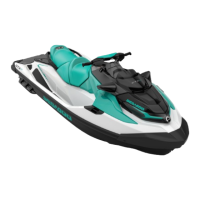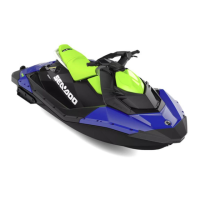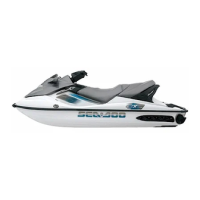Section 11 HULL/BODY
Subsection 02 (3D SERIES)
Compound fractures are those that have gone
past the gelcoated surface and in through the lay-
ers of fiberglass laminate. Two types of repairs
have to be performed. The first is to restore the
structural integrity of the damaged area. Fracture
types can vary from a simple crack to a large
hole. Usually, fiberglass reinforcement becomes
necessary, especially if the fracture can be at-
tributed to weakness. The final part of the repair
is the gelcoating, which cannot be done until the
interior and exterior laminate surfaces have been
repaired.
Outside
Remove the damaged gelcoat and fiberglass with
a 24-grit disk using a power sander. Grind out-
ward at least 2 inches from the fracture to allow
the patch to bond to strong material. Cut enough
pieces of fiberglass mat necessary to build up the
area. The pieces should be cut so they overlap
each other by at least a half inch. For a smoother
finish, the last layer should be fiberglass cloth. If
the fracture is small enough all you may have to
doisfilltheareawithanepoxyfiller.
Inside
For the interior repair, you can grind more. This
will allow for more fiberglass material which will
strengthen the area. If the fracture opening is too
large after surface preparation, you may need a
backing support to cover the opening. Cut alter-
nating pieces of fiberglass mat and cloth in over-
lapping sizes.
PATCHING THE REPAIR AREA
Outside
The outside should be done first. Wipe clean the
area with acetone on a cloth, then mask off area.
For a small crack use an epoxy filler in the same
way you would use gelcoat repair putty. When
laying up a larger area you will use mat, cloth and
fiberglass resin and catalyst. Use a clean contain-
er to mix the resin, mix only what you will need.
Follow the recommended catalyst ratio.
Using a clean paintbrush, brush the mixed resin on
the surface. Place the smallest piece of mat over
the fracture and then wet out the mat. Follow
with the remaining pieces of mat and final layer
of cloth. While wetting the pieces make sure you
work the air bubbles out and saturate all the pieces
evenly. Try to work quickly, you may only have
15 or 20 minutes. You may clean the brush with
acetone.
Wait until the repair has hardened before moving
on to the interior repair. If the size of the opening
is too large for the pieces to maintain the proper
shape, you will have to use a backing support. It
is a shaped piece of cardboard that fits flush to the
interior surface and has a plastic layer on the repair
side. It is held in place by tape or a support.
Inside
Wipe down the area with acetone on a cloth. Ap-
ply the same procedure as for outside repair when
laminating the alternating pieces of fiberglass ma-
terial. If a backing support was used, remove it
before starting the repair. After the area has hard-
ened, remove sharp edges of material from sur-
face. If required paint the surface.
SANDING
Outside
This surface will have to be prepared for applica-
tion of gelcoat. The size of the area will deter-
mine the gelcoating procedure to be used. Refer
to the REPAIR PROCEDURE FOR MINOR GEL-
COAT FRACTURES.
BUFFING AND WAXING
Refer to the BUFFING AND WAXING FOR MINOR
GELCOAT FRACTURES.
350 smr2005-069

